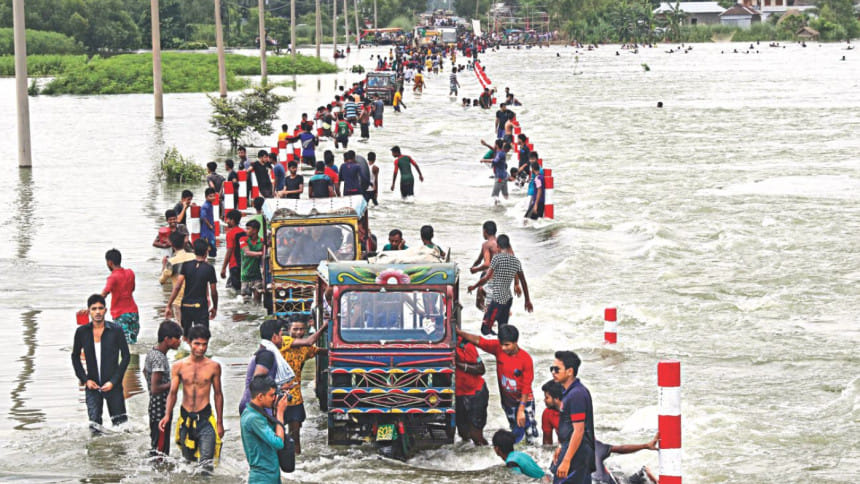North grapples with diseases as water recedes

Waterborne diseases are breaking out in the flood-affected northern region as water is receding and coming down to inundate fresh areas in the central parts of the country.
Though the flood situation is improving in the areas around the Brahmaputra and Jamuna rivers in Gaibandha, Jamalpur, Lalmonirhat, Kurigram, Sirajganj, and Bogra districts, people are still suffering, report our correspondents.
The Flood Forecasting and Warning Centre (FFWC) has meanwhile warned the water level of the Padma river may rise in next 48 hours. In that case, many areas in Rajbari, Manikganj, Munshiganj, Faridpur and Shariatpur districts might be affected.
Besides, flood situation around the capital is likely to deteriorate as water level in the rivers around Dhaka, including the Buriganga, the Balu and the Lakhya rivers, would rise, according to the FFWC forecast.
As the floodwater recedes, different waterborne diseases have broken out in the flood-prone areas in Lalmonirhat, reports our correspondent there.
People are forced to drink floodwater due to lack of drinking water and are affected by different waterborne diseases including diarrhoea, dysentery and typhoid.
Mahasina Bewa, 75, of Kalmari village in Sadar upazila has been suffering from diarrhoea after drinking flood water-mixed water.
Health Inspector in Lalmonirhat Mahbub Alam said medical teams have been working in the flood-affected areas. “We have not found any diarrhoea cases, but we are getting dysentery, fever and eczema patients,” he added.
Water has started receding in the district, but more than three lakh people are still marooned in 50 flood-hit unions, writes our Jamalpur correspondent.
Rail communications on the Jamalpur-Bangabandhu Bridge (east) and Jamalpur-Dewanganj routes remained suspended as the railway tracks went under water, said Jahurul Islam, station master at Jamalpur Railway Station.
“Rail communications on these routes will be suspended until the authorities declare the tracks fit for train operation,” he added.
Two 200 yard-long stretches of the Jamalpur-Sharishabari road in Phulbaria area have been eroded by the floodwater, suspending traffic movement on the route since Saturday morning, said Md Wahiduzzaman, executive engineer of Jamalpur Roads & Highways Department.
Standing crops in 17,045 hectares of land in the district were submerged, while 4,016 fish culture water bodies were flooded, washing away around 1,200 tonnes of fish, according to the district agriculture and fisheries officers.
The flood situation in Gaibandha remained unchanged, reports our Gaibandha correspondent.
Around 100 metres of the Sonail embankment collapsed due to the onrush of water at Sigria in Fulchhari upazila, flooding a vast area.
Fulchhari Upazila Parishad at Kalirbazar and the Upazila Health Complex went under knee-deep water. Road communications between the district headquarters and the upazila headquarters were also snapped, as the roads went under knee-to-waist-deep water at many points.
The victims who thronged the flood control embankment are facing acute shortage of food and drinking water. Besides, a serious crisis of fodder for the cattle prevails in the areas.
Fresh areas have meanwhile been inundated in Tangail, Munshiganj, Faridpur, Sherpur and Manikganj due to onrush of water from the upstream rivers.
Our correspondents from Lalmonirhat, Jamalpur, Gaibandha, Manikganj, Munshiganj, and Tangail have contributed to the story.

 For all latest news, follow The Daily Star's Google News channel.
For all latest news, follow The Daily Star's Google News channel. 



Comments